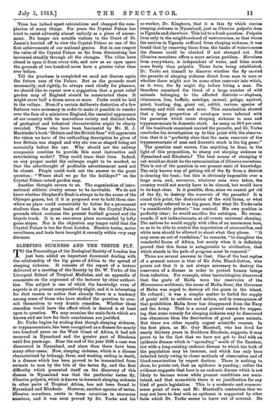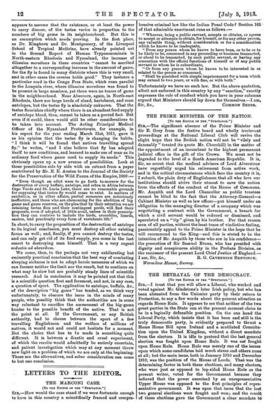SLEEPING SICKNESS AND THE TSETSE FLY.
TO the Proceedings of the Zoological Society of London has just been added an important document dealing with the relationship of the big game of Africa to the spread of sleeping sickness. It consists of the report of a lecture delivered at a meeting of the Society by Dr. W. Yorke, of the Liverpool School of Tropical Medicine, and an appendix of comments on the argument of the lecturer by other authori- ties. The subject is one of which the knowledge even of experts is at present comparatively slight, and it is interesting for that reason to notice that already there is a tendency among some of those who have studied the question to com- mit themselves to very drastic remedies. Whether those remedies would have the effect which is desired is at least open to question. We may examine the main facts which are known and see how far their conclusions are justified.
Dr. Yorke begins by stating that though sleeping sickness, or trypanosomiasis, has been recognized as a disease for nearly two hundred years on the West Coast of Africa, it had not occurred in Nyasaland and the greater part of Rhodesia until five years ago. Near the end of the year 1908 a case was discovered in Nyasaland, and since then there have been ninny other cases. Now, sleeping sickness, which is a disease characterized by lethargy, fever, and wasting ending in death, is a disease which has been proved to be transmitted from animals to men by the bite of the tsetse fly, and the first difficulty which presented itself on the discovery of this disease in Nyasaland was that the particular tsetse fly, Glossina palpalis, which is known to transmit sleeping sickness in other parts of Tropical Africa, has not been found in Nyasaland and Rhodesia. However, another species of tsetse, Glossina morsitans, exists in these countries in enormous numbers, and it was soon proved by Dr. Yorke and his
co-worker, Dr. Kinghorn, that it is this fly which carries sleeping sickness in Nyasaland, just as Glossina palpalis does in Uganda and elsewhere. This led to a fresh question. Palpalis lives only in the neighbourhood of watercourses, so that where the natives in Uganda suffered from sleeping sickness, it was found that by removing them from the banks of watercourses the disease could be checked if not stamped out. But Glossina morsitans offers a more serious problem. Morsitans lives everywhere, is independent of water, and bites much more freely than palpalis. These facts being established. Dr. Yorke set himself to discover whether the fly carried the parasite of sleeping sickness direct from man to man or whether there might not be some other reservoir into which, as it were, the fly might dip before biting a man. He therefore examined the blood of a large number of wild animals belonging to the affected districts — elephants rhinoceros, lion, buffalo, antelope, caracal, galago, squirrel, genet, hunting dog, giant rat, rabbit, various species of monkey, and wild rats and mice. This examination showed that a large proportion of antelopes were infected with the parasites which cause sleeping sickness in man and trypanosomiasis in domestic stock. As many as 66.6 per cent. of the bushbuck examined carried the parasite, and Dr. Yorke concludes his investigation up to this point with the observa- tion that it is "perfectly clear that the main reservoir of the trypanosomiasis of man and domestic stock is the big game."
The question next occurs, Can anything be done, in the light of this proposition, to stamp out sleeping sickness in Nyasaland and Rhodesia ? The best means of stamping it out would no doubt be the extermination of Glossina morsitans. This is out of the question in our present state of knowledge. The only known way of getting rid of the fly from a district is clearing the bush ; but this is obviously impossible over a large area, and, moreover, whatever area were taken, the country would not merely have to be cleared, but would have to be kept clear. Is it possible, then, since we cannot get rid of the fly, to destroy the reservoir of the parasite? It is round this point, the destruction of the wild fauna, or what are vaguely referred to as big game, that what Dr. Yorke calls "a considerable polemic " has centred. His own position is perfectly clear ; he would sacrifice the antelopes. He recom- mends, if not indiscriminate, at all events universal shooting. The natives he would supply with rifles of an uncommon bore, so as to be able to control the importation of ammunition, and white men should be allowed to shoot what they please. "It may seem an act of vandalism," he remarks, "to slaughter the wonderful fauna of Africa, but surely when it is definitely proved that this fauna is antagonistic to civilization, that which stands in the path of progress must be removed."
There are several answers to that. One of the best replies of a general nature is that of Sir John Bland-Sutton, who points out that it is not always necessary to destroy the reservoirs of a disease in order to protect human beings from infection. For example, when bacteriologists discovered that the goats of Malta were the reservoirs of the Micrococcus melitensis, the cause of Malta fever, the Governor of Malta was urged to destroy all the goats in the island. He refused ; it was a simpler matter to forbid the supply of goats' milk to soldiers and sailors, and in consequence of that prohibition Malta fever has disappeared from the Navy and the Army. That is a sound general reason for suppos- ing that some remedy for sleeping sickness may be discovered less obnoxious than the destruction of great game animals. But there are other equally cogent scientific reasons. In the first place, as Mr. Guy Marshall, who has lived for nearly thirteen years in Southern Rhodesia, suggests, it may prove to be the fact that we have not got to deal with an epidemic disease which is " spreading" south of the Zambesi, but with a long-existing endemic disease to which the bulk of the population may be immune, and which has only been detected lately owing to closer methods of observation and of blood-examination by expert doctors. There is nothing to show, he points out, that an epidemic is pending ; rather the evidence suggests that here is an endemic disease which is not likely to become worse while present conditions are main- tained, and that meanwhile there is no justification for any kind of panic legislation. This is a moderate and common- sense point of view, and Mr. Marshall's contention that wo may not have to deal with an epidemic is supported by other facts which Dr. Yorke seems to leave out of account. He appears to assume that the existence, or at least the power to carry disease, of the tsetse varies in proportion to the numbers of big game in its neighbourhood. But this is an assumption which needs proving. In the first place, as Dr. Kinghorn and Dr. Montgomery, of the Liverpool School of Tropical Medicine, have already pointed out in the Second Report of Human Trypanosomiasis in North-eastern Rhodesia and Nyasaland, the increase of Glossina morsitans in these countries " cannot be ascribed altogether to a corresponding increase in the amount of game, for the fly is found in many districts where this is very small, and in other cases the reverse holds good." They instance a particular road in the Congo Free State, which runs parallel to the Luapula river, where Glossina morsitans was found to be present in large numbers, yet there were no traces of game in the neighbourhood. Near Abercorn, again, in North-east Rhodesia, there are large herds of eland, hartebeest, and roan antelopes, but the tsetse fly is absolutely unknown. That the tsetse flourishes chiefly where there is an abundant food supply of antelope blood, then, cannot be taken as a proved fact. But even if it could, there would still be other considerations to be taken into account. The Acting Principal Medical Officer of the Nyasaland Protectorate, for example, in his report for the year ending March 31st, 1911, gave it as his opinion that the tsetse fly is changing its habits.
" I think it will be found that natives travelling spread fly," he -writes, "and I also believe that fly has adapted itself to new conditions, and learned to make use of man as its ordinary food where game used to supply its needs." This obviously opens up a new avenue of possibilities. Look at those possibilities side by side with an extract from a paper contributed by Mr. E. E. Austen to the Journal of the Society for the Preservation of the Wild Fauna of the Empire, 1908 :—
" Even though an edict were to go forth to-morrow for the destruction of every buffalo, antelope, and zebra in Africa between Cape Verde and St. Lucia Lake, there are no reasonable grounds for supposing that tsetse fly would cease to exist. In matters of sanitation, as in other affairs, partial measures are notoriously ineffective, and those who are clamouring for the abolition of big game and game reserves, on the plea that by their retention we are retaining tsetse flies and their contingent perils, will find their proposals, even if adopted, of little avail, unless in their prescrip- tion they can contrive to include the birds, crocodiles, lizards, snakes, and practically every form of vertebrate life."
In short, to carry the proposition of the destruction of antelope to its logical conclusion, you must destroy all other existing fauna as well ; and, finally, if you cannot destroy the tsetse, and can only get rid of its food supply, you come in the last resort to destroying man himself. That is a very cogent reductio ad absurdum.
We come, then, to the perhaps not very exhilarating but eminently practical conclusion that the best way of combating sleeping sickness is not to adopt heroic measures of which we can foresee neither the limit nor the result, but to continue on what may be slow but are probably steady lines of scientific research. And in conclusion it may be pointed out that this is a scientific question first and foremost, and not, in any case, a question of sport. The application to antelope, buffalo, &c., of the description "big game" has tended, as we think very unfortunately, to obscure the issue in the minds of many people, who possibly think that the authorities are in some way reluctant to sacrifice the amusement of the big-game hunter to the possible benefit of the native. That is not tbe point at all. If the Government, or any British authority, bad to choose between the sport of a few travelling Englishmen and the welfare of millions of natives, it would not and could not hesitate for a moment. But the choice that has to be made is something quite different. It is between a drastic and cruel experiment, of which the results would admittedly be entirely uncertain, and patient investigation which may at any moment throw new light on a problem of which we are only at the beginning. Those are the alternatives, and sober consideration can come to but one conclusion.



















































 Previous page
Previous page